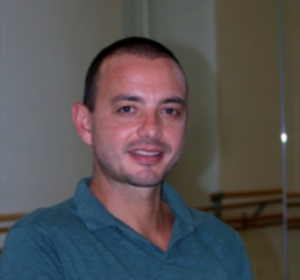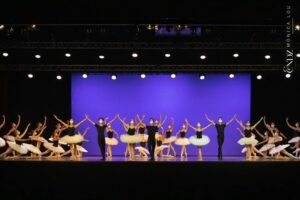Classical Intensive: the faculty of teachers and selected ballet
The return of Wim Broeckx, Paquita and the repertoire workshops of Jiří Kylián and David Dawson, the keys to Valencia Endanza 2022
The thirteenth edition of Valencia Endanza will once again feature a select group of internationally acclaimed professionals of international stature. Among others and because of the close relationship that links him to our course, we would like to highlight the return of Wim Broeckx, former Principal dancer at Het National Ballet in Amsterdam and former President of Prix de Lausanne. Due to the closure of the Australian borders during the first two years of the pandemic, it has been impossible to count on the Belgian maestro, who will will teach Classical dance and men’s repertoire.
Trained at the renowned Vaganova Academy and former dancers at the prestigious Mariinsky Ballet of St. Petersburg and Dresden Semperoper, Olga Melnikova and Vitali Fadeev are currently teachers at the Palucca University Hochschule für Tanz in Dresden. In the Intensive Classical programme, Melnikova will teach Classical dance, repertoire and character dances, while Fadeev will teach classical dance, repertoire and technique for men.
Following the tradition of joining synergies and efforts in the study of a great Classical repertoire and as a demonstration of the necessary teamwork, on this occasion, the faculty has decided to work about Paquita (1846), a work about the love affairs of a gypsy heroine in the midst of the Napoleonic invasion, about which you can find more detailed information at the bottom of this publication.
In addition, we will be holding a choreographic workshop focusing on the repertoire of the Czech choreographer Jiří Kylián, who was artistic director of Nederlands Dans Theater for 25 years and one of the most influential choreographers of the last quarter of the 20th century. Kylián’s repertory workshop will be Given by Sébastien Mari, former dancer of Nederlands Dans Theater. The choreographic workshop on repertoire by David Dawson, winner of the Benois de la Danse Prize – the ‘Oscar’ of ballet – and closely linked to the Dresden Semperoper Ballet. Will be given by Dawson´s choreographic assistant Raphaël Coumes-Marquet. We invite you to get to know the the trajectory of our teachers of the Classical Intensive with the biographies at the bottom of the page, listed alphabetically by surname.
As you will know from previous editions, Valencia Endanza offers three levels in the Classical Intensive: Classical I (from the age of 10 or 4th year of elementary school), whose program consists of Classical dance, pointe/men’s technique, Classical group repertoire, jazz and character dance. Classical II (from 13 years of age or 2nd year of professional education), whose classes will be in Classical dance, pointe/technique for repertoire, contemporary dance and jazz; and Classical III (from the age of 15 or 4th year of vocational training), whose program consists of Classical dance, pointe/men’s technique, repertoire, pas de deux (depending on the anti-Counseling protocol), and choreographic workshops.
To keep up to date with Valencia Endanza‘s news, we encourage you to stay tuned to our social networks. We would like to remind you that for the second consecutive year, Valencia Endanza returns to the resort of Mas Camarena, between 18th and 30th July 2022.
«Paquita», the gypsy heroine against the napoleonic invasion
Working on the Classical repertoire is a way of preserving a legacy and to learn the style through the little details of those who have danced these masterpieces of ballet in the past. Aware of the importance of passing on their wisdom to future generations, the teaching staff of our international course takes great care in the selection of a masterpiece from the repertoire, on which they work on various adapted different fragments according to the technical level, which will be assembled as a suite to the delight of those attending the corresponding edition of the Valencia Endanza Closing Gala.
This year, our teachers have chosen Paquita (1846), original choreography by the master of the Paris Opera Joseph Mazilier on music by French composer Édouard Deldevez. The premiere took place at the Parisian Opéra Le Peletier and starred the starred the famous star of romantic ballet Carlotta Grisi in the role of Paquita, and Lucien Petipa – brother of Marius Petipa – as Lucien d’Hervilly.
Set in the city of Saragossa during the Napoleonic invasion, Paquita tells the story of a young gypsy girl, who is courted by Iñigo, the tribe’s chief of the tribe, who falls in love with Lucien d’Hervilly. After a series of entanglements in which the governor is also involved, finally, thanks to a medallion, Paolo, Paquita discovers her noble origins and is able to marry her beloved Lucien.
The success of the play was such that when Marius Petipa fled Spain in 1847 and settled in St. Petersburg as master of the Imperial Ballet, Paquita was the first Imperial Ballet, even playing the male lead. Later, in 1881, he commissioned composer Ludwig Minkus to create additional music and introduced some fragments, such as the well-known Grand Pas Classique, the pas de trois of Paquita in the first act or the Mazurka des enfants. Around 1904, Petipa’s choreography for the Imperial Ballet was recorded by the Stepanov notation system, while the Marseille-born composer was working with Anna Pavlova for the debut in the title role. This notation enabled Pierre Lacotte to reliably reconstruct the piece for the Paris Opera Ballet in 2001.
Biographies of the Classical Intensive faculty

Wim Broeckx, former president of the Prix de Lausanne and former Principal Dancer of the Het Nationale Ballet in Amsterdam
Born in Antwerp (Belgium), Broeckx began studying dance at the age of ten in his hometown. As a professional dancer, he developed a successful career in four international companies, especially the Het Nationale Ballet in Amsterdam, where he reached the rank of principal dancer and became assistant artistic director.
Appointed director of the Dance Department of the Royal Conservatory of The Hague in 2002 – where he specialized in the repertoire of George Balanchine and the Nederlands Dans Theater- Artistic president of the Prix de Lausanne in 2008, Broeckx has been a member of the jury at major international competitions.
Since 2012, he has been working independently as a teacher, and consultant, and has been recognised for his commitment to the healthy and responsible and healthy training of young ballet dancers and for his work to promote ballet and ensure its recognition as a profession.
Settled in Australia in 2019, Wim Broeckx has been head of the Pre-Professional Division and the Pre-Professional Division and is rehearsal director of the Queensland Ballet School. Currently he is guest freelance teacher at several schools and companies in Australia.

Raphaël Coumes-Marquet, choreographic assistant to David Dawson
Born in Besançon (France) and trained at the École de l’Opéra de Paris, Raphaël Coumes-Marquet developed a distinguished professional career as a soloist with Les Ballets de Monte-Carlo, the Wiener Staatsoper and Het Nationale Ballet of Amsterdam; and as principal with Dresden Semperoper Ballett. As a performer, his repertoire encompassed the main roles of the great Classics, neoclassical works and contemporary pieces.
In addition, he was a guest dancer with the English National Ballet and the National Ballet of Croatia and was a regular at numerous international galas and festivals. In 2015 he became ballet master at the Dresden Semperoper Ballett, as well as coordinator of the Semper Zwei project. Choreographer of the Dresden Semper Opernball since 2009 and of the ZDF Silvester Concert, Coumes-Marquet directed the collaborative creation Alice.
He currently works as choreographic assistant for David Dawson’s repertoire and as a regular guest teacher with companies such as Les Ballets de Monte-Carlo, the Dresden Semperoper Ballett, Het Nationale Ballet of Amsterdam and the Badisches Staatstheater Karlsruhe.

Vitali Fadeev, Professor of Classical Dance at Palucca University Hochschule für Tanz
Born in St. Petersburg (Russia), Vitali Fadeev trained at the prestigious Vaganova Academy between 1989 and 1993. After graduating, he joined the then Kirov Ballet – now known as the Mariinsky Ballet – where he remained until 2000. That year he joined the Dresden Semperoper Ballett, German company from which he retired in 2015 as a demisolist.
As a performer, Vitali Fadeev covered a wide stylistic range, ranging from roles in romantic works such as La Sylphide, to classics such as Swan Lake, The Nutcracker or The Sleeping Beauty, to neoclassical works such as The Sleeping Beauty, to neoclassical works by George Balanchine or pieces by Jiří Kylián, among others. He has created roles with choreographers such as Uwe Scholz, David Dawson, Robert Nord, Stijn Celis and Vladimir Derevianko.
Between 2013 and 2017, she trained as a teacher of the Vaganova method at the famous academy of the same name and later began his time as a professor at the at the Palucca Hochschule für Tanz in Dresden, which he combines with his work as a guest ballet master at the Yacobson Ballet Company Theater in St. Petersburg.

Sébastien Mari, teacher of the Jiří Kylián repertoire workshop.
Born in La Rochelle (France), Sébastien Mari began his training at the conservatoire of his home town, where he graduated with the Gold Medal of the Conservatoires de France. In 1989, he made his professional premiere with the Jeune Ballet de France and subsequently developed a long career with prestigious companies such as the Nederlands Dans Theater – under the direction of Jiří Kylián-, the National Dance Company, the Gulbenkian Ballet of Portugal and the Ballettmainz of Germany.
During these years, she danced a very heterogeneous repertoire of works by the most influential choreographers of the world, such as Nacho Duato, Mats Ek, William Forsythe, Jiří Kylián, Ohad Naharin, Hans Van Manen, Itzik Galilli, among others. Since 2014, Sébastien Mari has been a guest teacher in numerous international companies, mainly in Germany and the Netherlands. His interests have led him to experiment with different methods such as Gyrotonic, the Alexander technique and yoga, giving him a broader vision of body learning to finally develop his own teaching system.

Olga Melnikova, classical dance teacher at Palucca University Hochschule für Tanz
Born in St. Petersburg (Russia), Olga Melnikova graduated from the Vaganova Academy in 1989 and joined the prestigious Kirov Ballet in her hometown. – renamed the Mariinsky Ballet of St. Petersburg – where she developed her career until 2000, when she joined the Dresden Semperoper Ballett. She was promoted to the Dresden Semperoper Ballett as a soloist in 2007.
In 2007 she was promoted to principal dancer. As a performer, her repertoire includes the leading roles in the great classics, as well as roles in neo-classical as well as roles in neoclassical and contemporary works. . She has worked with choreographers of the stature of John Neumeier, William Forsythe, Jiří Kylián, Uwe Scholz, Aaron S. Watkin, David Dawson, Yuri Grigorovich, Oleg Vinogradov, Andris Liepa, Vladimir Derevianko, Vladimir Vasiliev and Vasily Medvedev, among others.
In 2010 she began to develop her teaching career, first as a ballet teacher at the Dresden Semperoper Ballett and later as a guest professor at the Palucca Hochschule für Tanz. A year later she became a permanent member of the staff of the Palucca Hochschule für Tanz as a teacher of classical dance, where she still where she remains today.


